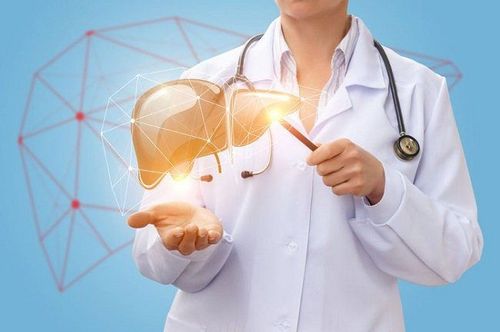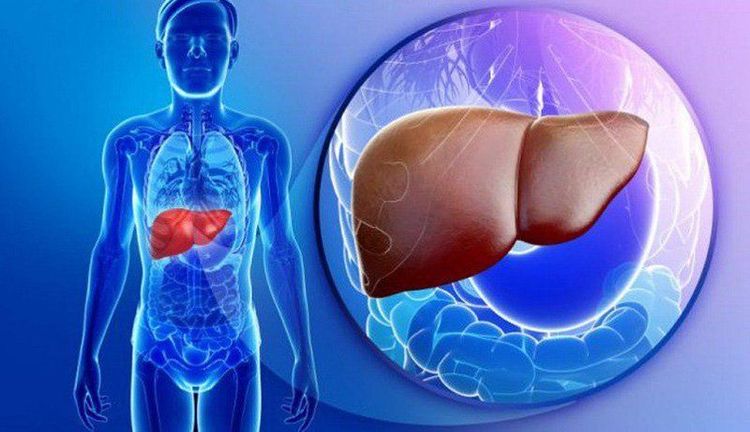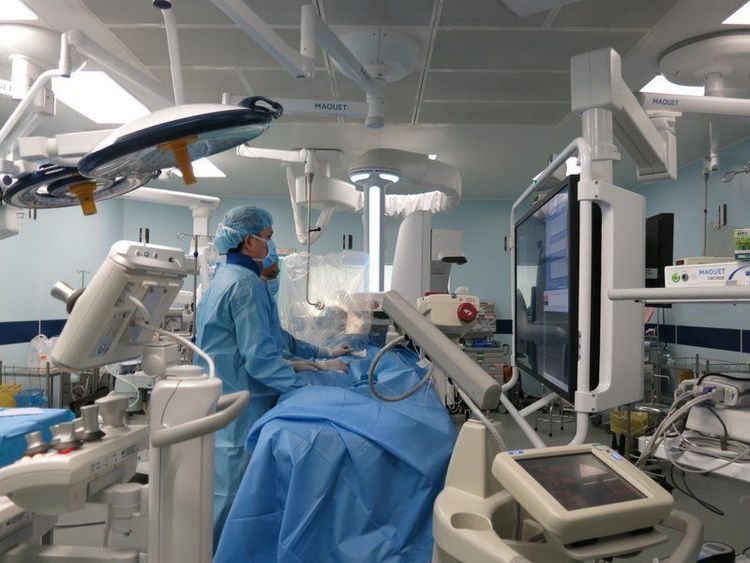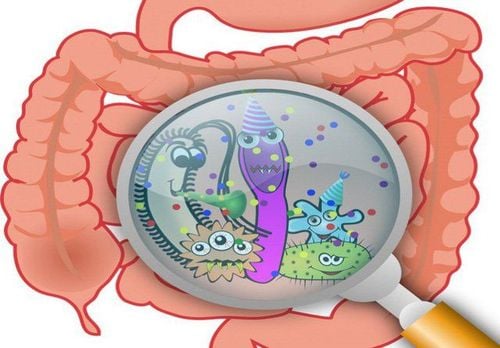This is an automatically translated article.
The article was professionally consulted by Dr. Bui Xuan Truong - Department of General Internal Medicine - Vinmec Times City International General Hospital.A - Some outlines of the liver The liver is the largest solid organ in the human body, lying to the right in the upper half of the abdomen and separated from the rib cage by the diaphragm. The average weight of an adult liver is about 1.2-1.6 kg. The liver is responsible for many physiological functions of the body such as: hematopoiesis (mainly in the fetal and neonatal period), bile production, detoxification, glucose synthesis and glycogen storage for the body, protein synthesis, synthesis of some coagulation factors, fat metabolism (lipid), alcohol metabolism, drug metabolism (many drugs are metabolized by the liver)... Therefore, severe liver failure can lead to death. death.
The liver is composed of many types of cells and is divided into 2 large groups, (1) parenchymal cells (hepatocytes) - accounting for 80% of the total mass of the liver and (2) other types of cells ( non-parenchymal cells) - make up 20% of the total liver mass, such as cells responsible for immune functions, cells that make up the hepatic sinusoids (Sinusoidal endothelial cells), cells that make up the bile duct system (bile ducts) , cells that make up the vascular system in the liver, cells in the lymphatic system.....
Unlike many other organs and organs in the body, the liver is supplied with blood by two sources: (1) arteries: (1) arteries liver, part of the arterial system that supplies blood from the heart to the organs in the body, (2) the portal vein is made up of the mesenteric and splenic veins - bringing blood from the intestines and spleen to the liver. The hepatic artery supplies only 30% of the total blood volume to the liver, but up to 70% of the oxygen supply to the liver. In contrast, the portal vein supplies 70% of blood to the liver, but only 30% of the oxygen supply to the liver. Blood that leaves the liver will be collected into the veins on the liver, there are 3 veins on the liver, and pours into the inferior vena cava and then returns to the heart.
Every day, in an adult, the liver secretes about 400-600ml of bile, this amount of bile will follow the bile duct to the intestine. Bile fluid plays an important role in the digestion and absorption of food, especially fats and some essential vitamins for the body such as vitamins A, D, K and E.

B - How many types of liver tumors are there and are all types of liver tumors cancerous According to the usual habit when it comes to tumors, we often associate it with Cancer, but in many cases where the tumor is not cancerous.
As mentioned above, the liver is made up of many different types of cells, so there are many different types of liver tumors and different characteristics of the tumor, not all liver tumors are liver cancer. .
Liver tumors are divided into 2 groups:
1. Non-cancerous liver tumors - Benign liver tumors: Liver cysts: the liver can have 1 cyst or many cysts, there are many different types of liver cysts. Some types of liver cysts can become cancerous but are rare. Hemangioma in the liver: hemangioma is a common word - familiar, but more accurately it must be a vascular malformation proliferating in the liver. Benign mass hyperplastic tumor: although it is a type of hyperplastic tumor, there is almost no risk of malignancy into cancer. Tumor - Adenoma in the liver: this is a common tumor in women who have used oral contraceptives for a long time or seen in people with glycogen storage disorders, men with sex hormone disorders. This type of tumor has the potential - the risk of malignancy into cancer or the possibility of rupture causing bleeding. Fatty tumors in the liver Smooth muscle tumors in the liver Fibroids in the liver Vietnam, along with China, Japan, Korea, Korea and some countries in Southeast Asia, Africa... countries with the highest rates of liver cancer in the world.
Every year, the world detects about 600,000 new HCC patients and 650,000 patients die from liver cancer, of which 75-80% belong to Asian countries.
2. Tumor group is cancerous – malignant liver tumor: Malignant liver tumor includes two main groups: (1) Primary liver cancer, this is the type of tumor - cancer that originates in the liver first. , (2) Secondary liver cancer, this is a type of tumor- cancer that has spread from cancers in other organs to the liver. Hepatocellular carcinoma (HCC): this is the most common and most common type of liver cancer, accounting for 85-90% of all liver cancer cases. Cholangiocarcinoma (CCC: cholangiocarcinoma): cholangiocarcinoma can be found extrahepatic - in the hilum and intrahepatic, in which the incidence in the liver is very low. Cholangiocarcinoma has a much lower rate than hepatocellular carcinoma. Metastatic liver cancer: these are tumors - liver cancer caused by metastases from cancers in other organs to the liver such as: stomach cancer, colon cancer, ovarian cancer, cancer pancreas... Other rare liver cancer: as malignant transformation of certain types of liver tumors - benign.

C - What kind of people will be in the group of patients who need to be monitored and screened for hepatocellular carcinoma periodically Asian men, including Vietnam, aged 40 years and older Asian women , including Vietnam, 50 years of age or older People with chronic hepatitis B virus disease People with chronic hepatitis C virus infections People with a history of close family members ( grandfather, grandmother, father, mother, siblings....) have liver cancer Cirrhosis of the liver from any cause: hepatitis virus, alcohol, metabolic disorder.... .. Living in an area with a high rate of poisoning with some risk factors for liver cancer such as Aflatoxin..... Recently, some medical studies showed that patients with type-diabetes- II, smoking, severe fatty liver or obesity should also be screened periodically.

D - Why it is necessary to conduct periodic examinations to screen for hepatocellular cancer and screening methods To be effective in the treatment of hepatocellular cancer requires a combination and cohesion of many specialized in medicine, health: epidemiology, general examination, specialty, imaging, laboratory, histopathology, surgery, oncology and medical communication. The goal of treatment for liver cancer, like other cancers, is to remove the cancer tissue, prolong the life after treatment and ensure the quality of life after treatment for the patient. Minimizing the financial burden for the patient, the patient's family and the society. To achieve this goal, the detection of the disease at an early stage and a very early stage plays a decisive role. Even if hepatocellular cancer is properly treated and treated at an early or very early stage, there is still a possibility of recurrence. Alpha-fetoprotein (AFP - αFP) is the most widely used and widely used biomarker in the diagnosis and screening of hepatocellular carcinoma. However, the use of the AFP test alone has the potential to miss about 40% of patients, so it needs to be combined with imaging, most commonly ultrasound. The average time for testing and periodic inspection is every 6 months. However, in patients with chronic liver disease (especially due to hepatitis B virus, hepatitis C virus), cirrhosis with regenerative nuclei should be monitored more closely and the follow-up interval should be 3 months. /1 times.
Patients after treatment for HCC should be monitored according to the following schedule: after 1 month of treatment - after 3 months of treatment and every 3 months for at least the first 2 years after treatment.
All patients with a liver tumor larger than 1cm in size for the first time should do an in-depth diagnosis with imaging: multi-sequence CT scan with contrast injection, nuclear magnetic resonance imaging (MRI). MRI) with contrast injection or ultrasound with contrast injection.
When imaging and blood test data are not conclusive, a liver biopsy should be performed.

E - Treatment methods for hepatocellular cancer The selection of a treatment method (a method or a combination of several methods) on an individual patient basis should be based on the following factors:
Stage of the tumor liver tumor and liver tumor location. Pathological stage of the liver: about 80-85% of hepatocellular carcinomas arise on a background of cirrhosis, especially in people with chronic hepatitis B virus and hepatitis C virus infection. General condition and other diseases of the patient. It is not possible to have a single treatment for all patients with hepatocellular carcinoma.
Treatment methods for hepatocellular carcinoma:
Partial hepatectomy Liver transplantation Necrosis and removal of liver tumors by radiofrequencyablation (RFA: radiofrequencyablation) Necrosis and removal of liver tumors by alcohol injection Embolization: cutting off the source of blood vessels feeding the liver tumor (embolization can be combined with chemotherapy or in combination with radioisotope) Chemotherapy, now there are many new drugs that have been successfully researched and introduced. and apply practical treatment such as: Sorafenib, Brivanib, Linifanib, Everolimus, Ramicirumab.... Radiation therapy: with the advent of the latest generation of machines, Varian True Beam, the role of radiation therapy in treatment of hepatocellular carcinoma began to be mentioned - more attention. However, the results still need to be verified further. For the generation of radiotherapy machines from Gamma-knife and Cyber-knife and earlier: not yet approved by prestigious Scientific and Medical organizations of the US, Europe, Asia-Pacific, Japan. ... recommended to consider it as a routine method in the treatment of hepatocellular carcinoma.
Note: Some other hepatocellular carcinoma treatments are not mentioned. These methods are either due to insignificant treatment effectiveness or insufficient verifiable data, and secondly, there are too many unwanted side effects but the results are not high. Therefore, those methods are not currently mentioned by reputable scientific and medical organizations in official recommendations, and many methods are not currently used by advanced medicine - applied in treatment. treat.













